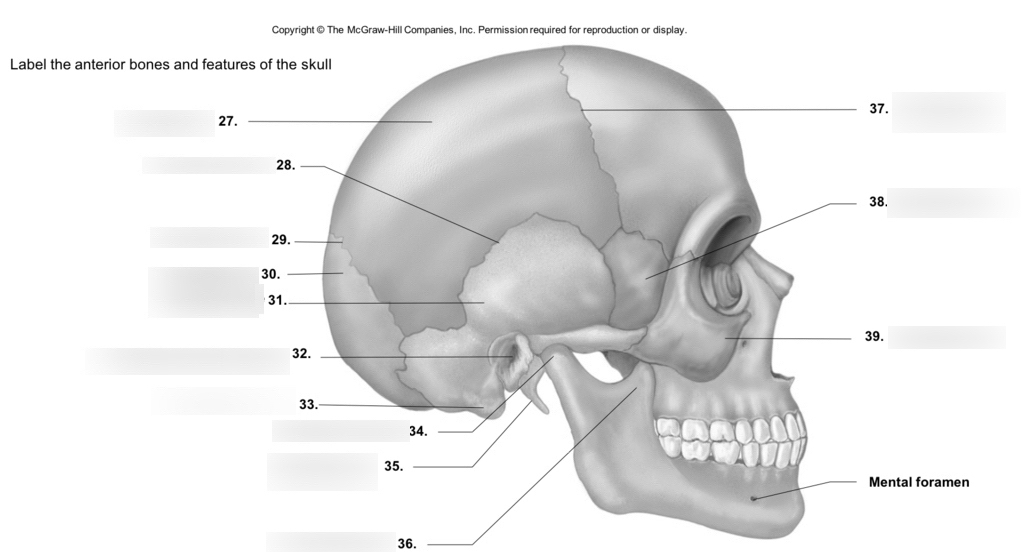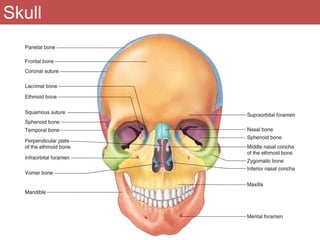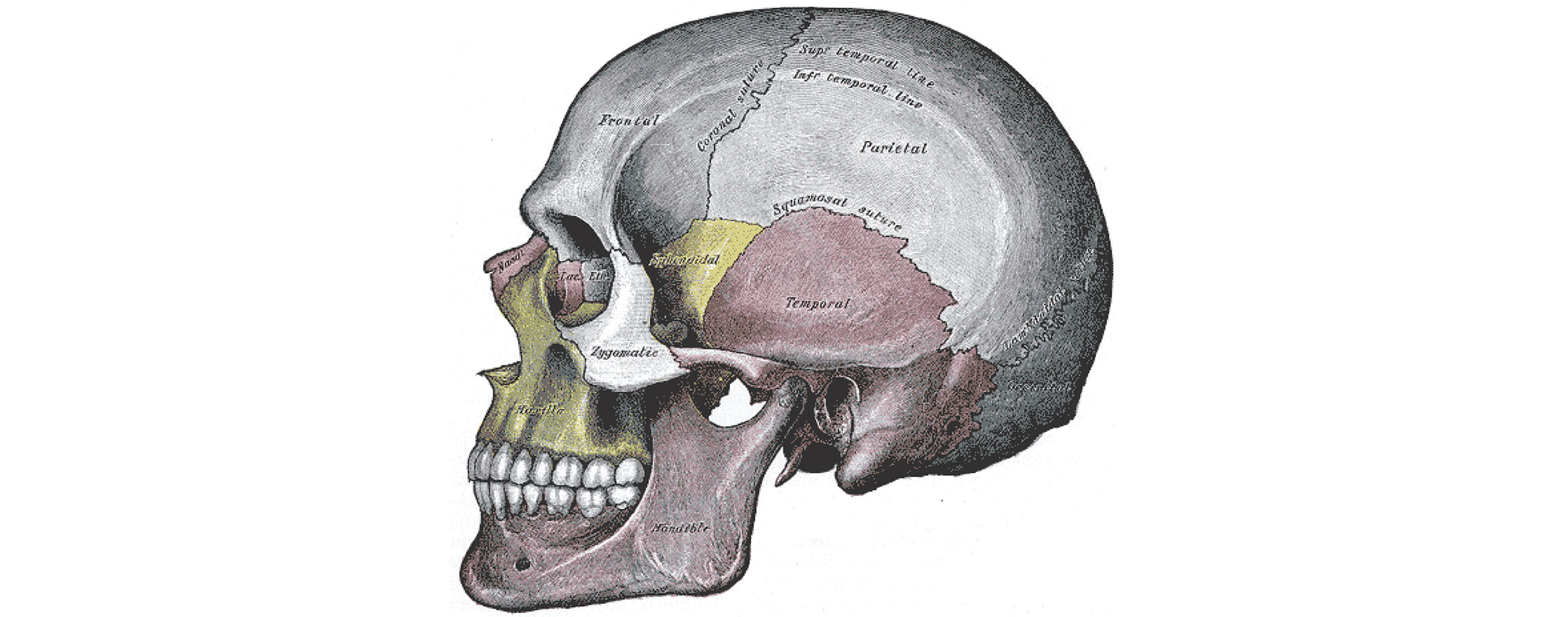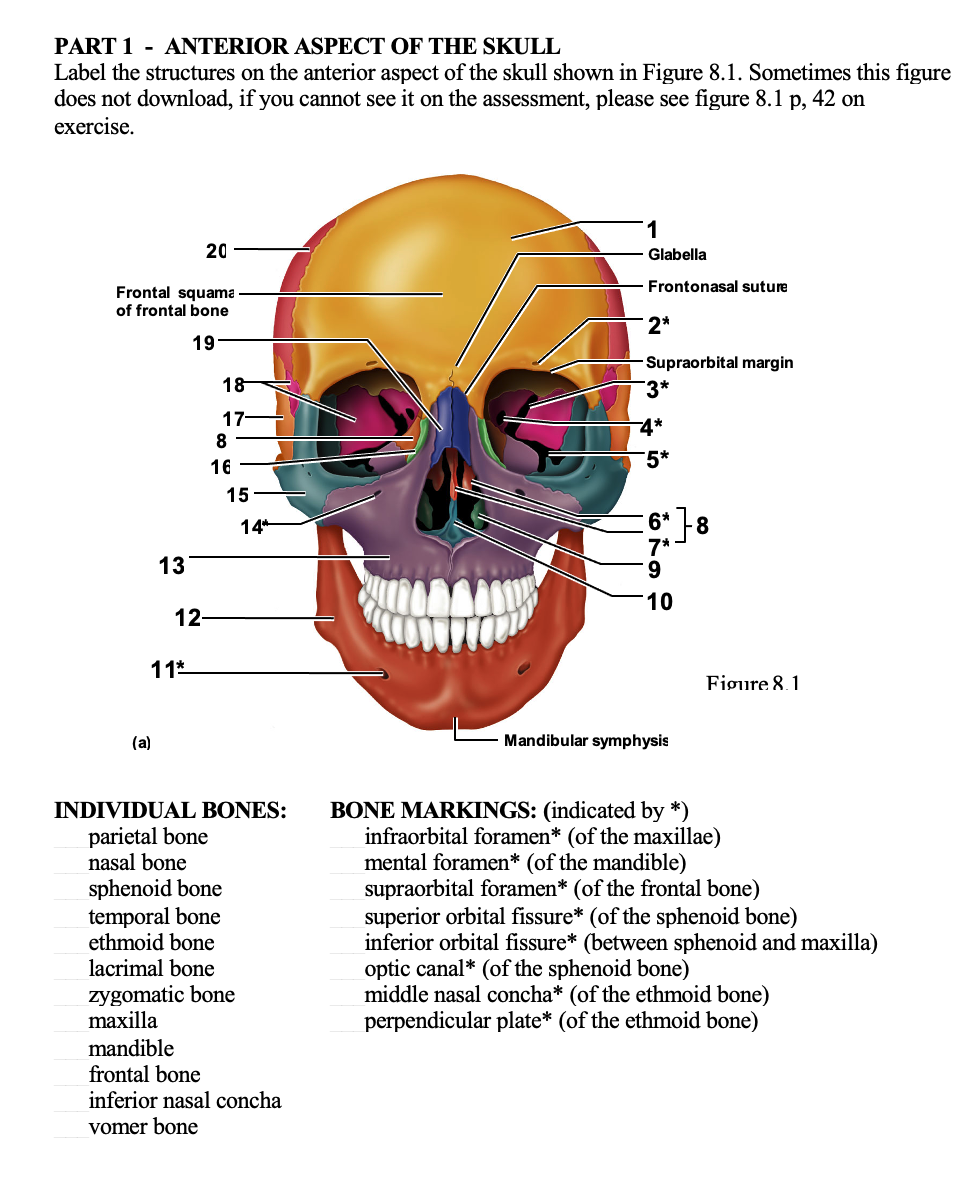43 figure 14.1 label the anterior bones and features of the skull
Lab 14: Figure 14.10 Anterior Features of the Skull - Quizlet Terms in this set (9) ; Frontal Bone · Frontal Bone ; Nasal Bone · Nasal Bone ; Zygomatic Bone · Zygomatic Bone ; Infraorbital Foramen · Infraorbital Foramen ; Maxilla. PDF Laboratory Manual for Human Anatomy & Physiology Fetal Pig Version, 4e ... Revised and added leader lines and labels New figures Revised and expanded components 13 Pre-Lab Figure 13.2 (bone features) Added questions Added labels 14 Pre-Lab Procedure (skull) Figure 14.1, 14.2, 14.4, 14.5, 14.11 (skull) Figure 14.3 (mandible) Figure 14.11 (lateral view of skull) Assessments: Part A and Part D Added questions
Solved Label the bones of the skull as seen in the anterior ... Label the bones of the skull as seen in the anterior view. Lacrimal Parietal Zygomatic Maxilla Ethmoid Mandible Ne Vomer Frontal Nasal Sphenoid Ethmoid Mandible Vomer Frontal Nasal Sphenoid Reset Zoom Levator scapula Causes movement of scapula Causes movement of humerus Infraspinatus Teres major Pectoralis minor Supraspinatus Trapezius Rhomboid

Figure 14.1 label the anterior bones and features of the skull
6.3 Bone Structure - Anatomy and Physiology 2e | OpenStax Bones of the pelvis, skull, spine, and legs are the most commonly affected. When occurring in the skull, Paget's disease can cause headaches and hearing loss. Figure 6.14 Paget's Disease Normal leg bones are relatively straight, but those affected by Paget's disease are porous and curved. What causes the osteoclasts to become overactive? 7.1 Divisions of the Skeletal System - OpenStax The axial skeleton of the adult consists of 80 bones, including the skull, the vertebral column, and the thoracic cage. The skull is formed by 22 bones. Also associated with the head are an additional seven bones, including the hyoid bone and the ear ossicles (three small bones found in each middle ear). Lab 14: Figure 14.11 Lateral View of the Skull Diagram | Quizlet Lab 14: Figure 14.11 Lateral View of the Skull STUDY Learn Write Test PLAY Match + − Created by THagge TEACHER Terms in this set (14) Parietal ... Squamosal Suture ... Temporal Bone ... Lambdoidal Suture ... Occipital Bone ... External Acoustic Meatus ... Coronal Suture ... Frontal Bone ... Zygomatic Process ... Zygomatic Bone ... Maxilla ...
Figure 14.1 label the anterior bones and features of the skull. Visit wwwmhhecommartinseries1 for pre lab questions - Course Hero (if the line lacks the word bone, label the particular feature of that bone.) 1 2occipital bone (1) lambdoid suture external occipital protuberance foramen magnum occipital condyle temporal bone (2) squamous suture external acoustic meatus mandibular fossa mastoid process styloid process carotid canal jugular foramen internal acoustic meatus … PDF 'l-f,------ - That Science Life Figure 14.1 Label the anterior bones and features of the skull. (If the line lacks the word bone,label the particular feature of that bone .) (bone) .,' -z(bone) ^ Lacrimal bone Ethmoid bone (bone) Sphenoid bone (bone) (bone) (bone) (bone) 14 14 16 (bone) Fi.gure 14.2 Label the lateral bones and features of the skull. (bone) .'' /hnna\ \vv' 16.5 Musculoskeletal System - Concepts of Biology | OpenStax The joints between the bones in the skull and between the teeth and the bone of their sockets are examples of fibrous joints (Figure 16.16a). Cartilaginous joints are joints in which the bones are connected by cartilage (Figure 16.16b). An example is found at the joints between vertebrae, the so-called "disks" of the backbone. 19.1 Types of Skeletal Systems - Concepts of Biology - 1st Canadian Edition The human pectoral girdle consists of the clavicle (or collarbone) in the anterior, and the scapula (or shoulder blades) in the posterior (Figure 19.11). Figure 19.11. (a) The pectoral girdle in primates consists of the clavicles and scapulae. (b) The posterior view reveals the spine of the scapula to which muscle attaches.
Skull and C-Spine Lab Images from Lab Manual - Figure 14.1 Label the ... ANATOMY AN ANATOMY AN 101 Skull and C-Spine Lab Images from Lab Manual - Figure 14.1 Label the anterior bones and features of the skull. (If the line lacks the word bone, label Skull and C-Spine Lab Images from Lab Manual - Figure 14.1... School University of Kentucky Course Title ANATOMY AN 101 Type Lab Report Uploaded By christine97 Pages 4 Craniosynostosis in the Middle Pleistocene human Cranium 14 from the ... Relevant features in Cranium 14. (A) Posterior view, showing the parallelogram profile and the ipsilateral occipito-mastoid bulge, both diagnostic features of the left lambdoid suture premature fusion.Note the deviation of the sagittal plane with respect to the sagittal suture plane, showing that the Inion, the occipital crest and other medial structures of the nuchal plane are positioned 10 ... The vertebral column of the Regourdou 1 Neandertal - ScienceDirect Figure 1. The first cervical vertebra or atlas (C1) of Regourdou 1 (R1) in cranial (left), and caudal (right) views. The 'virtual' label of this vertebra is V#ai + V#ay (no physical label). V#ai represents the right lateral mass and the fragment of the posterior arch. V#ay represents the anterior arc. Skeletal elements of the penguin eye and their functional and ... In birds, it is reinforced by both bone and cartilage. The bony element consists of a ring of scleral ossicles as well as, unique among vertebrates to some birds, the os opticus (os nervi optici, Gemminger's ossicle). The scleral ossicles are a ring of interlocking bones found at the anterior margin of the sclera near the corneo‐scleral junction.
A&P 1 Lab Figure 14.1 Bones & Features of the skull (anterior view ... Start studying A&P 1 Lab Figure 14.1 Bones & Features of the skull (anterior view). Learn vocabulary, terms, and more with flashcards, games, and other study tools. Lab 14: Figure 14.3 Inferior Bones of the Skull - Quizlet Start studying Lab 14: Figure 14.3 Inferior Bones of the Skull. Learn vocabulary, terms, and more with flashcards, games, and other study tools. Material properties of the human cranial vault and zygoma Occipital bone sites O2-O5 have unique features, including some of the thickest cortical bone in the skull. The distinct material properties of the occipital bone may relate to its functional role as an attachment area for the nuchal musculature, which functions in head posturing and movement. Lab 14: Figure 14.1 Anterior Bones of the Skull Diagram | Quizlet Start studying Lab 14: Figure 14.1 Anterior Bones of the Skull. Learn vocabulary, terms, and more with flashcards, games, and other study tools.
Solved bone) (bone From the provided list, enter in each - Chegg Transcribed image text: bone) (bone From the provided list, enter in each blank below the term that properly identifies each labeled part of the skull. As usual, your answer must be entered exactly as shown below in order to get credit. Use each term once and only once. coronal suture Lacrimal bone - frontal Ethmoid bone inferior nasal concha mandible bone) maxilla Sphenoid bone middle nasal ...
1.6 Anatomical Terminology - Anatomy and Physiology 2e - OpenStax The frontal plane is the plane that divides the body or an organ into an anterior (front) portion and a posterior (rear) portion. The frontal plane is often referred to as a coronal plane. ("Corona" is Latin for "crown.") The transverse plane is the plane that divides the body or organ horizontally into upper and lower portions.
Systematics of Eosemionotus The left hyomandibula is isolated and displaced posterodorsal to the skull in MCSN 8006 (Figure 6.2, Figure 9). The bone has a relatively narrow and slightly ventrally expanded shaft, with the hyomandibular foramen close to the anterior border, and a posteriorly expanded dorsal portion, but there is no distinct opercular process.
Solved Parietal one)... Frontal Coronel Suture, Labore bo- - | Chegg.com Frontal Coronel Suture, Labore bo- - Supra ortal foc MEN - Nasal Tampopal port osphenoid FO FIGURE 14.1 of that bone) 1 Label the anterior bones and features of the skull of the line lacks the word bone, label the particular feature KPR Donel bore) bonel Ethmoid bone (bone) bone) bone) (bone) (bone) FIGURE 14.2 Label the lateral bones and. Question: Parietal one)...
1. A&P 1 Lab Figure 14.1 Bones & Features of the skull ... Parietal Bone · Parietal Bone ; Frontal Bone · Frontal Bone ; Coronal Suture · Coronal Suture ; Lacrimal Bone · Lacrimal Bone ; ethmoid bone · ethmoid bone.
Intervertebral disc - Physiopedia The intervertebral disc (IVD) is important in the normal functioning of the spine. It is a cushion of fibrocartilage and the principal joint between two vertebrae in the spinal column. There are 23 discs in the human spine: 6 in the cervical region (neck), 12 in the thoracic region (middle back), and 5 in the lumbar region (lower back).
Musculoskeletal System - Bone Development Timeline Introduction. The adult human skeleton has about 206 different bones, each develop with their own specific bone timeline. Many prenatal bones fuse postnatal developing neonate and child (about 275). The two main forms of ossification occur in different bones, intramembranous (eg skull) and endochondral (eg vertebra) ossification.
7.2 The Skull - Anatomy and Physiology 2e | OpenStax The anterior skull consists of the facial bones and provides the bony support for the eyes and structures of the face. This view of the skull is dominated by the openings of the orbits and the nasal cavity. Also seen are the upper and lower jaws, with their respective teeth ( Figure 7.4 ).
CH 14 HW.pdf - 4/21/2021 CH 14 HW CH 14 HW Due: 11:59pm on... - Course Hero 4/21/2021 CH 14 HW 1/12 CH 14 HW Due: 11:59pm on Monday, April 12, 2021 To understand how points are awarded, read the Grading Policy for this assignment. Art Labeling Activity: Figure 14.1 Part A Label the parts of the upper respiratory system (1 of 2). Drag the labels onto the diagram to identify the parts of the upper respiratory system (1 of 2). ANSWER: Correct Art Labeling Activity ...
BW Lat Skull fig 14.2 lab-2 - Figure 14.2 Label the lateral bones and ... Figure 14.2 Label the lateral bones and features of the skull. (bone)1. Study Resources. Main Menu; by School; by Literature Title; by Subject; by Study Guides; Textbook Solutions Expert Tutors Earn. ... Anterior View of the Skull to Moodle. notes. 1. Lab 11 Images. University of Kentucky. ANATOMY AN 101.
BW AP Skull fig 14.1 lab - Figure 14.1 Label the anterior bones and ... ANATOMY AN ANATOMY AN 101 BW AP Skull fig 14.1 lab - Figure 14.1 Label the anterior bones and features of the skull. (If the line lacks the word bone, label the particular BW AP Skull fig 14.1 lab - Figure 14.1 Label the anterior... School University of Kentucky Course Title ANATOMY AN 101 Type Lab Report Uploaded By christine97 Pages 1
Lab 14: Figure 14.2 Lateral Bones of the Skull Diagram - Quizlet Start studying Lab 14: Figure 14.2 Lateral Bones of the Skull. Learn vocabulary, terms, and more with flashcards, games, and other study tools.
Lab 14: Figure 14.1 Anterior Bones of the Skull Diagram | Quizlet Lab 14: Figure 14.1 Anterior Bones of the Skull STUDY Learn Write Test PLAY Match + − Created by THagge TEACHER Terms in this set (16) Parietal ... Frontal ... Coronal Suture ... Supraorbital Foramen ... Nasal Bone ... Temporal Bone ... Perpendicular Plate of the Ethmoid Bone ... Infraorbital Foramen ... Vomer Bone ... Mandible ... Mental Foramen
Vertebral Column and Thoracic Cage Lab - Studyres Complete Parts A, B, C, and D. 1 Figure 14.1 Label the bones and features of the lateral view (left) and the posterior view (right) of the vertebral column. Figure 14.2 Label the superior views of the atlas and axis. 2 Figure 14.3 Label the features of the cervical, thoracic, and lumbar vertebrae. 3 Figure 14.4 Label the coccyx and the features ...
19.3 Joints and Skeletal Movement - Concepts of Biology - 1st Canadian ... Rheumatoid arthritis (RA) is an inflammatory disorder that primarily affects the synovial joints of the hands, feet, and cervical spine. Affected joints become swollen, stiff, and painful. Although it is known that RA is an autoimmune disease in which the body's immune system mistakenly attacks healthy tissue, the cause of RA remains unknown.
Skull Lab Exercise 14 06-15-2015 Flashcards - Quizlet 15 Jun 2015 — other anterior skull bones are: supraorbital foramen, nasal bone, ... Figure 14.1 from the side, the anterior bones and features of the ...
Fin Whale Sound Reception Mechanisms: Skull Vibration Enables Low ... Hearing mechanisms in baleen whales (Mysticeti) are essentially unknown but their vocalization frequencies overlap with anthropogenic sound sources. Synthetic audiograms were generated for a fin whale by applying finite element modeling tools to X-ray computed tomography (CT) scans. We CT scanned the head of a small fin whale (Balaenoptera physalus) in a scanner designed for solid-fuel rocket ...
Lab 14: Figure 14.11 Lateral View of the Skull Diagram | Quizlet Lab 14: Figure 14.11 Lateral View of the Skull STUDY Learn Write Test PLAY Match + − Created by THagge TEACHER Terms in this set (14) Parietal ... Squamosal Suture ... Temporal Bone ... Lambdoidal Suture ... Occipital Bone ... External Acoustic Meatus ... Coronal Suture ... Frontal Bone ... Zygomatic Process ... Zygomatic Bone ... Maxilla ...
7.1 Divisions of the Skeletal System - OpenStax The axial skeleton of the adult consists of 80 bones, including the skull, the vertebral column, and the thoracic cage. The skull is formed by 22 bones. Also associated with the head are an additional seven bones, including the hyoid bone and the ear ossicles (three small bones found in each middle ear).
6.3 Bone Structure - Anatomy and Physiology 2e | OpenStax Bones of the pelvis, skull, spine, and legs are the most commonly affected. When occurring in the skull, Paget's disease can cause headaches and hearing loss. Figure 6.14 Paget's Disease Normal leg bones are relatively straight, but those affected by Paget's disease are porous and curved. What causes the osteoclasts to become overactive?
























Post a Comment for "43 figure 14.1 label the anterior bones and features of the skull"